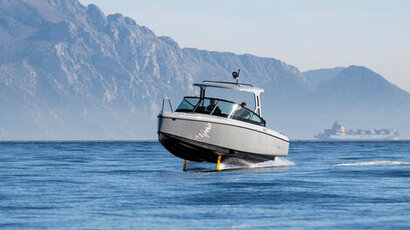
A Candela C-8 Polestar Edition completed the voyage from Sotogrande, Spain, to Ceuta, North Africa - a 24-nautical mile trip - in just over one hour, matching the speed of conventional fast ferries. After recharging, the vessel returned to the Spanish mainland the same day.
Beneath the surface, two hydrofoils - underwater wings - lift the C-8 above the water, drastically reducing drag and cutting energy consumption by 80 percent over conventional fast vessels. This in turn enables the long electric range needed to cross the Strait of Gibraltar - one of the world’s busiest shipping lanes - for the first time.
The voyage was undertaken to demonstrate the potential of Candela’s new P-12 electric hydrofoil ferry to deliver clean, cost-efficient transport both along the Spanish coast and across the Strait. Currently, this vital corridor - with over 3.5 million annual crossings - is dominated by large diesel car ferries that primarily serve major hubs, making travel time-consuming for those living outside key terminals. Candela aims to complement these essential services by introducing fast, sustainable direct routes that expand access for underserved coastal communities.
“There’s a clear need for additional fast, clean, and efficient travel options across the Mediterranean - and for direct lines that wouldn’t be economically viable with larger, conventional vessels” said Gustav Hasselskog, CEO of Candela and pilot during the crossing. “We can help meet this demand, working alongside existing operators and ferries to boost connectivity and cut emissions - not just across the Strait but also along the coast, for example connecting cities along the Costa del Sol.”
The Gibraltar Strait - where cold Atlantic waters meet the warmer Mediterranean - is known for strong currents and unpredictable seas, making conditions challenging for smaller vessels and uncomfortable for passengers prone to seasickness. This made it an ideal test for Candela’s computer-controlled hydrofoil system, which is often described as a “magic pill” for motion sickness. Using sensors to detect waves, wind, and current, the system automatically adjusts the hydrofoils up to 100 times per second - delivering a ride that feels more like flying than boating.
“It functions much like the flight controller of a modern jet fighter, and works very well” added Mr Hasselskog. “We couldn’t feel the waves, while the photo boat was bouncing around quite a bit.”
During the voyage, the Candela C-8 used just 40 kWh of energy - about 8 euros worth. By comparison, the similarly sized gasoline-powered photo boat burned 50 litres of fuel, costing around 90 euros.
This 90 percent cost reduction is another key to enabling new routes across the Mediterranean.
“We slash energy use by 80 percent, eliminate emissions, and enable fast, smooth crossings at a fraction of the cost - opening the door to entirely new, sustainable ferry routes across the Mediterranean” said Mr Hasselskog.
The crossing was made in partnership with Avangreen, the clean energy company behind Ceuta’s largest solar plant and other electrification projects. Together, Candela and Avangreen aim to lay the foundation for a new era of sustainable maritime infrastructure.
For additional information:

